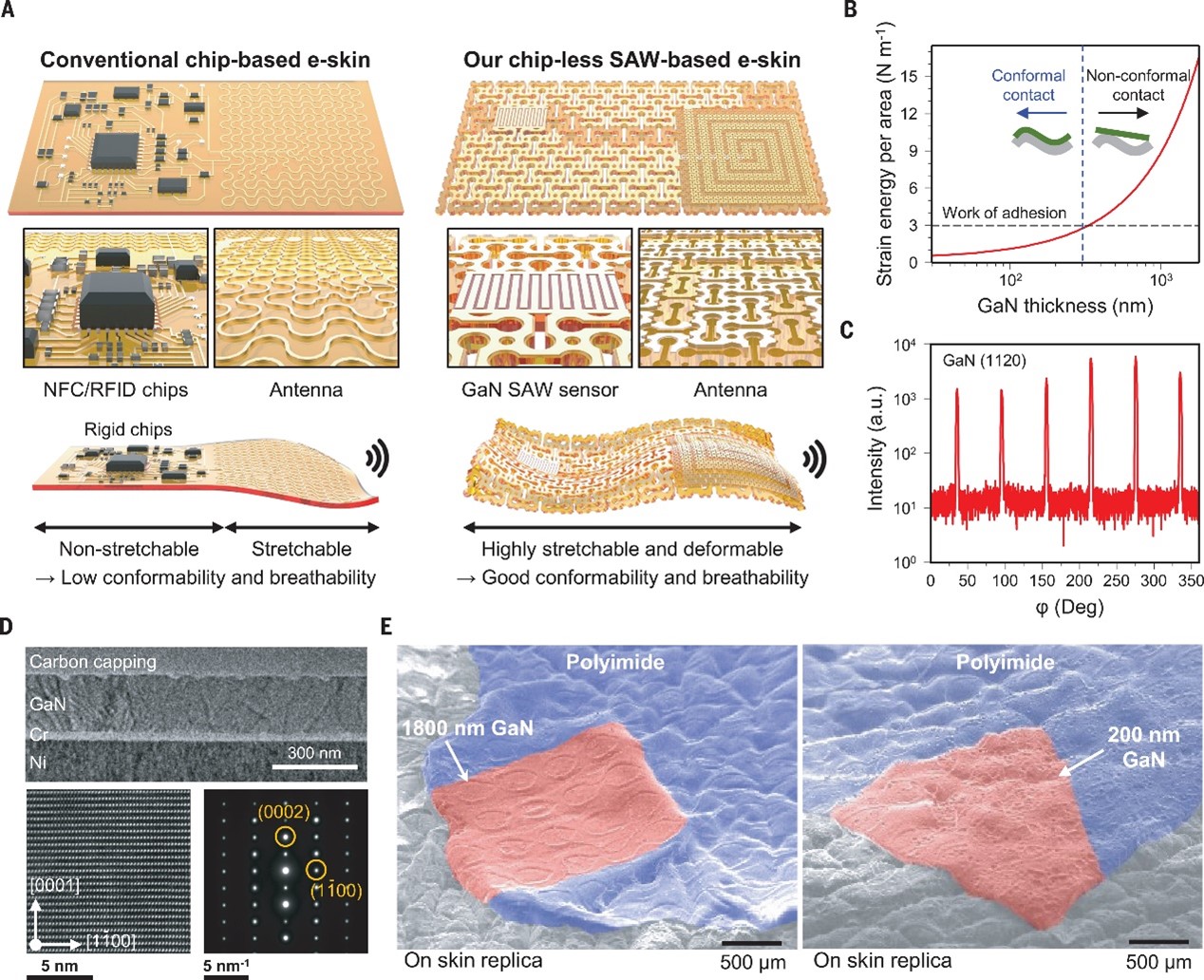热点文献带您关注电子皮肤的最新进展——图书馆前沿文献专题推荐服务(72)
2022-10-28

在上一期AI文献推荐中,我们为您推荐了人工智能的最新发展前沿,包括用于图像分类的片上光子深度神经网络,基于多层数字编码超表面阵列的可编程衍射深度神经网络,一种基于尖峰神经形态硬件的长短时记忆,以及适用于多智能任务机器人的时空弹性神经形态计算芯片TianjicX。
电子皮肤可模仿人体皮肤对外界环境的感知,在医疗健康、智能机器人等领域有着广阔的应用前景,是当今重要的前沿研究方向之一。本期我们为您选取了4篇文献介绍电子皮肤的最新发展前沿,包括利用纤维Bragg光栅和深层神经网络的大面积触觉敏感皮肤,可用于无线健康监测设备的基于表面声波传感器的无芯片无线电子皮肤,基于印刷突触晶体管的可感受“疼痛”的电子皮肤,一种由水凝胶和硅胶弹性体组成的具有触觉感应能力的仿生弹性机器人皮肤,推送给相关领域的科研人员。
文献一 利用纤维Bragg光栅和深层神经网络的触觉敏感皮肤
Functional mimicry of Ruffini receptors with fibre Bragg gratings and deep neural networks enables a bio-inspired large-area tactile-sensitive skin
Massari, Luca, etc.
NATURE MACHINE INTELLIGENCE, 2022, 4(5): 425–435
Collaborative robots are expected to physically interact with humans in daily living and the workplace, including industrial and healthcare settings. A key related enabling technology is tactile sensing, which currently requires addressing the outstanding scientific challenge to simultaneously detect contact location and intensity by means of soft conformable artificial skins adapting over large areas to the complex curved geometries of robot embodiments. In this work, the development of a large-area sensitive soft skin with a curved geometry is presented, allowing for robot total-body coverage through modular patches. The biomimetic skin consists of a soft polymeric matrix, resembling a human forearm, embedded with photonic fibre Bragg grating transducers, which partially mimics Ruffini mechanoreceptor functionality with diffuse, overlapping receptive fields. A convolutional neural network deep learning algorithm and a multigrid neuron integration process were implemented to decode the fibre Bragg grating sensor outputs for inference of contact force magnitude and localization through the skin surface. Results of 35 mN (interquartile range 56 mN) and 3.2 mm (interquartile range 2.3 mm) median errors were achieved for force and localization predictions, respectively. Demonstrations with an anthropomorphic arm pave the way towards artificial intelligence based integrated skins enabling safe human–robot cooperation via machine intelligence.阅读原文:https://www.nature.com/articles/s42256-022-00487-3

文献二 基于表面声波传感器的无芯片无线电子皮肤
Chip-less wireless electronic skins by remote epitaxial freestanding compound semiconductorsKim, Yeongin, etc.
SCIENCE, 2022, 377(6608): 859-869
Recent advances in flexible and stretchable electronics have led to a surge of electronic skin (e-skin)based health monitoring platforms. Conventional wireless e-skins rely on rigid integrated circuit chips that compromise the overall flexibility and consume considerable power. Chip-less wireless e-skins based on inductor-capacitor resonators are limited to mechanical sensors with low sensitivities. We report a chipless wireless e-skin based on surface acoustic wave sensors made of freestanding ultrathin single-crystalline piezoelectric gallium nitride membranes. Surface acoustic wave-based e-skin offers highly sensitive, low-power, and long-term sensing of strain, ultraviolet light, and ion concentrations in sweat. We demonstrate weeklong monitoring of pulse. These results present routes to inexpensive and versatile low-power, high-sensitivity platforms for wireless health monitoring devices.
阅读原文:https://www.science.org/doi/10.1126/science.abn7325

文献三 基于印刷突触晶体管的机器人电子皮肤
Printed synaptic transistor–based electronic skin for robots to feel and learn
Liu, Fengyuan, etc.
SCIENCE ROBOTICS, 2022, 7(67)
An electronic skin (e-skin) for the next generation of robots is expected to have biological skin-like multimodal sensing, signal encoding, and preprocessing. To this end, it is imperative to have high-quality, uniformly responding electronic devices distributed over large areas and capable of delivering synaptic behavior with long- and short-term memory. Here, we present an approach to realize synaptic transistors (12-by-14 array) using ZnO nanowires printed on flexible substrate with 100% yield and high uniformity. The presented devices show synaptic behavior under pulse stimuli, exhibiting excitatory (inhibitory) post-synaptic current, spiking rate-dependent plasticity, and short-term to long-term memory transition. The as-realized transistors demonstrate excellent bio-like synaptic behavior and show great potential for in-hardware learning. This is demonstrated through a prototype computational e-skin, comprising event-driven sensors, synaptic transistors, and spiking neurons that bestow biological skin-like haptic sensations to a robotic hand. With associative learning, the presented computational e-skin could gradually acquire a human body–like pain reflex. The learnt behavior could be strengthened through practice. Such a peripheral nervous system–like localized learning could substantially reduce the data latency and decrease the cognitive load on the robotic platform.
阅读原文:https://www.science.org/doi/10.1126/scirobotics.abl7286
文献四 一种具有触觉感应能力的仿生弹性机器人皮肤
A biomimetic elastomeric robot skin using electrical impedance and acoustic tomography for tactile sensing
Park, K., etc.
SCIENCE ROBOTICS, 2022, 7(67)
Human skin perceives physical stimuli applied to the body and mitigates the risk of physical interaction through its soft and resilient mechanical properties. Social robots would benefit from whole-body robotic skin (or tactile sensors) resembling human skin in realizing a safe, intuitive, and contact-rich human-robot interaction. However, existing soft tactile sensors show several drawbacks (complex structure, poor scalability, and fragility), which limit their application in whole-body robotic skin. Here, we introduce biomimetic robotic skin based on hydrogel-elastomer hybrids and tomographic imaging. The developed skin consists of a tough hydrogel and a silicone elastomer forming a skin-inspired multilayer structure, achieving sufficient softness and resilience for protection. The sensor structure can also be easily repaired with adhesives even after severe damage (incision). For multimodal tactile sensation, electrodes and microphones are deployed in the sensor structure to measure local resistance changes and vibration due to touch. The ionic hydrogel layer is deformed owing to an external force, and the resulting local conductivity changes are measured via electrodes. The microphones also detect the vibration generated from touch to determine the location and type of dynamic tactile stimuli. The measurement data are then converted into multimodal tactile information through tomographic imaging and deep neural networks. We further implement a sensorized cosmetic prosthesis, demonstrating that our design could be used to implement deformable or complex-shaped robotic skin.
阅读原文:https://www.science.org/doi/10.1126/scirobotics.abm7187
往期精彩推荐
热点论文解读AI应用领域 ——图书馆前沿文献专题推荐服务(3)
热点论文带您探究5G和未来通信——图书馆前沿文献专题推荐服务 (4)
前沿文献带您解读自然语言处理技术 ——图书馆前沿文献专题推荐服务(5)
热点论文带您探究5G和未来通信材料技术领域 ——图书馆前沿文献专题推荐服务(6)
热点文献带您关注AI情感分类技术 ——图书馆前沿文献专题推荐服务(7)
热点论文带您探究6G的无限可能——图书馆前沿文献专题推荐服务(8)
热点文献带您关注AI文本摘要自动生成 ——图书馆前沿文献专题推荐服务(9)
热点论文:5G/6G引领社会新进步——图书馆前沿文献专题推荐服务(10)
热点文献带您关注AI机器翻译 ——图书馆前沿文献专题推荐服务(11)
热点论文与您探讨5G/6G网络技术新进展——图书馆前沿文献专题推荐服务(12)
热点文献带您关注AI计算机视觉 ——图书馆前沿文献专题推荐服务(13)
热点论文与带您领略5G/6G的硬科技与新思路 ——图书馆前沿文献专题推荐服务(14)
热点文献带您关注AI计算机视觉 ——图书馆前沿文献专题推荐服务(15)
热点论文带您领略5G/6G的最新技术动向 ——图书馆前沿文献专题推荐服务(18)
热点文献带您关注图神经网络——图书馆前沿文献专题推荐服务(19)
热点论文与带您领略5G/6G材料技术的最新发展——图书馆前沿文献专题推荐服务(20)
热点文献带您关注模式识别——图书馆前沿文献专题推荐服务(21)
热点论文与带您领略6G网络技术的最新发展趋势 ——图书馆前沿文献专题推荐服务(22)
热点文献带您关注机器学习与量子物理 ——图书馆前沿文献专题推荐服务(23)
热点论文与带您领略5G/6G通信器件材料的最新进展 ——图书馆前沿文献专题推荐服务(24)
热点文献带您关注AI自动驾驶——图书馆前沿文献专题推荐服务(25)
热点论文与带您领略5G/6G网络安全和技术的最新进展——图书馆前沿文献专题推荐服务(26)
热点文献带您关注AI神经网络与忆阻器——图书馆前沿文献专题推荐服务(27)
热点论文与带您领略5G/6G电子器件和太赫兹方面的最新进展——图书馆前沿文献专题推荐服务(28)
热点文献带您关注AI与机器人——图书馆前沿文献专题推荐服务(29)
热点论文与带您领略5G/6G热点技术的最新进展——图书馆前沿文献专题推荐服务(30)
热点文献带您关注AI与触觉传感技术——图书馆前沿文献专题推荐服务(31)
热点论文与带您领略5G/6G热点技术的最新进展——图书馆前沿文献专题推荐服务(32)
热点文献带您关注AI深度学习与计算机视觉——图书馆前沿文献专题推荐服务(33)
热点论文与带您领略未来通信的热点技术及最新进展——图书馆前沿文献专题推荐服务(34)
热点文献带您关注AI强化学习——图书馆前沿文献专题推荐服务(35)
热点论文与带您领略5G/6G基础研究的最新进展——图书馆前沿文献专题推荐服务(36)
热点文献带您关注AI与边缘计算——图书馆前沿文献专题推荐服务(37)
热点论文与带您领略5G/6G领域热点研究的最新进展——图书馆前沿文献专题推荐服务(38)
热点文献带您关注AI技术的最新进展——图书馆前沿文献专题推荐服务(39)
热点论文与带您领略5G相关领域研究的最新进展——图书馆前沿文献专题推荐服务(40)
热点文献带您关注AI视觉跟踪——图书馆前沿文献专题推荐服务(41)
热点论文带您领略未来通信在海空领域研究的最新进展——图书馆前沿文献专题推荐服务(42)
热点文献带您关注AI与医学研究——图书馆前沿文献专题推荐服务(43)
热点论文带您领略未来通信在材料领域研究的最新进展——图书馆前沿文献专题推荐服务(44)
热点文献带您关注AI与医学图像——图书馆前沿文献专题推荐服务(45)
热点论文带您领略未来通信在光电材料及信息编码领域的最新进展——图书馆前沿文献专题推荐服务(46)
热点文献带您关注AI与生物学——图书馆前沿文献专题推荐服务(47)
热点论文带您领略未来通信在新材料技术领域的最新进展——图书馆前沿文献专题推荐服务(48)
热点文献带您关注AI与人脸识别——图书馆前沿文献专题推荐服务(49)
热点论文带您领略光电半导体领域的最新进展——图书馆前沿文献专题推荐服务(50)
热点文献带您关注AI在集成电路领域的最新进展——图书馆前沿文献专题推荐服务(51)
热点论文带您领略半导体领域的最新进展——图书馆前沿文献专题推荐服务(52)
热点文献带您关注AI在光神经网络领域的最新进展——图书馆前沿文献专题推荐服务(53)
热点论文带您领略未来通信在新材料技术领域的最新进展——图书馆前沿文献专题推荐服务(54)
热点文献带您关注AI深度神经网络的最新进展——图书馆前沿文献专题推荐服务(55)
热点论文带您领略新材料半导体领域的最新进展——图书馆前沿文献专题推荐服务(56)
热点文献带您关注AI视频动作识别的最新进展——图书馆前沿文献专题推荐服务(57)
热点论文带您领略未来通信热点技术的最新进展——图书馆前沿文献专题推荐服务(58)
热点文献带您关注AI深度学习的最新进展——图书馆前沿文献专题推荐服务(59)
热点论文带您领略未来通信研究热点的最新进展——图书馆前沿文献专题推荐服务(60)
热点文献带您关注AI领域的最新进展——图书馆前沿文献专题推荐服务(61)
热点论文带您探索智能化以及超表面在未来通信中的应用——图书馆前沿文献专题推荐服务(62)
热点文献带您关注AI领域的最新进展——图书馆前沿文献专题推荐服务(63)
热点论文带您领略半导体领域的最新进展——图书馆前沿文献专题推荐服务(64)
热点文献带您关注AI领域的最新进展——图书馆前沿文献专题推荐服务(65)
热点论文带您探索新型网络架构以及超表面在未来通信中的应用——图书馆前沿文献专题推荐服务(66)
热点文献带您关注AI深度强化学习的最新进展——图书馆前沿文献专题推荐服务(67)
热点论文带您探索新型网络架构以及超材料在未来通信中的应用——图书馆前沿文献专题推荐服务(68)
热点文献带您关注AI图神经网络的最新进展——图书馆前沿文献专题推荐服务(69)
热点论文带您探索未来网络中使用的新材料以及相关技术 ——图书馆前沿文献专题推荐服务(70)
热点文献带您关注AI的最新进展——图书馆前沿文献专题推荐服务(71)